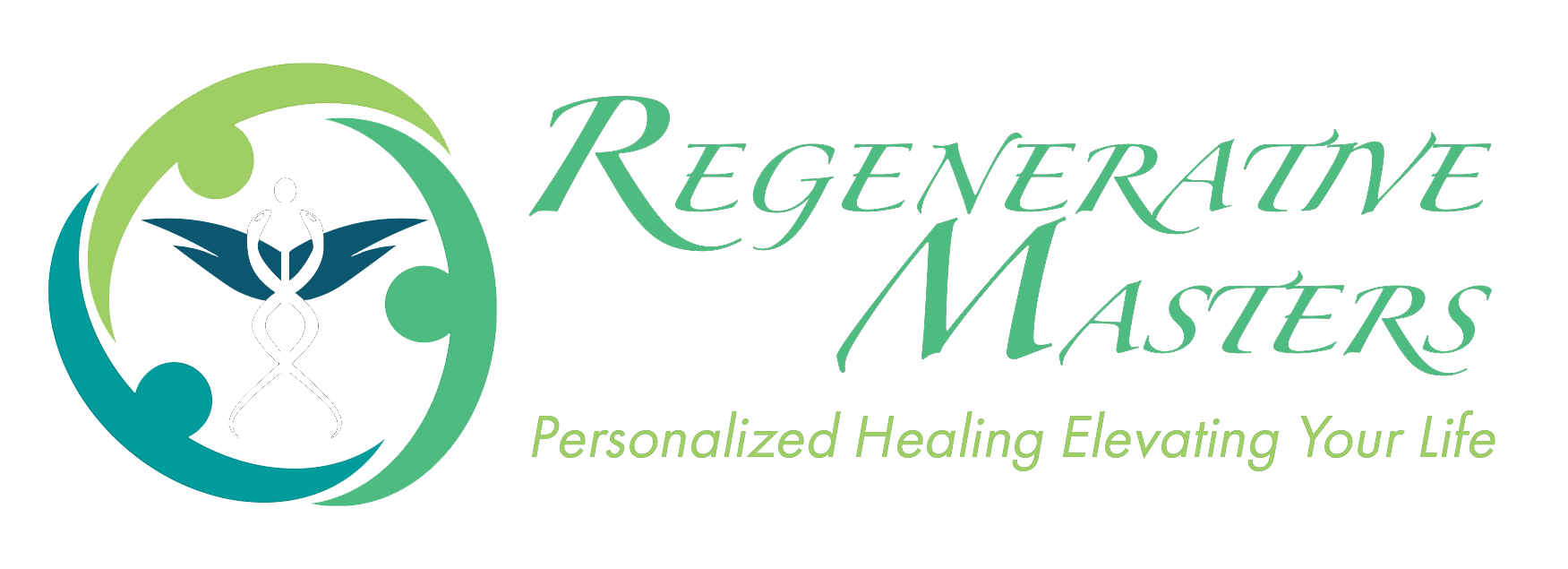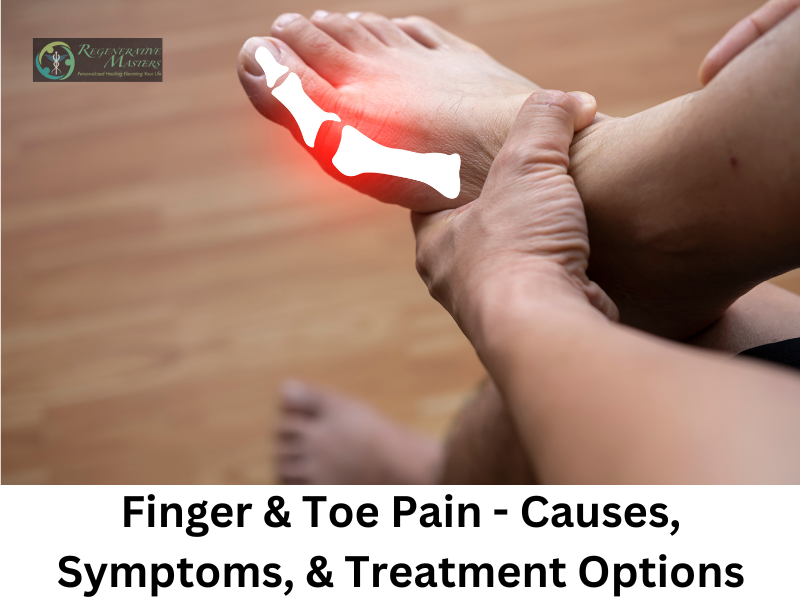In our daily lives, finger and toe pain can be an unpleasant companion, causing discomfort and impeding our ability to accomplish simple chores. The impact can be considerable, whether from arthritis, repetitive strain damage, injuries, or disorders such as gout.
Learning about finger and toe pain causes, symptoms, and treatment options are critical for developing effective remedies and relieving the suffering caused by these conditions. Various methods exist, from home remedies and self-care techniques to professional medical procedures to manage and cope with finger and toe pain. So, let’s explore this important topic and look for strategies to encourage better hand and foot health.
Finger & Toe Pain — Causes & Symptoms
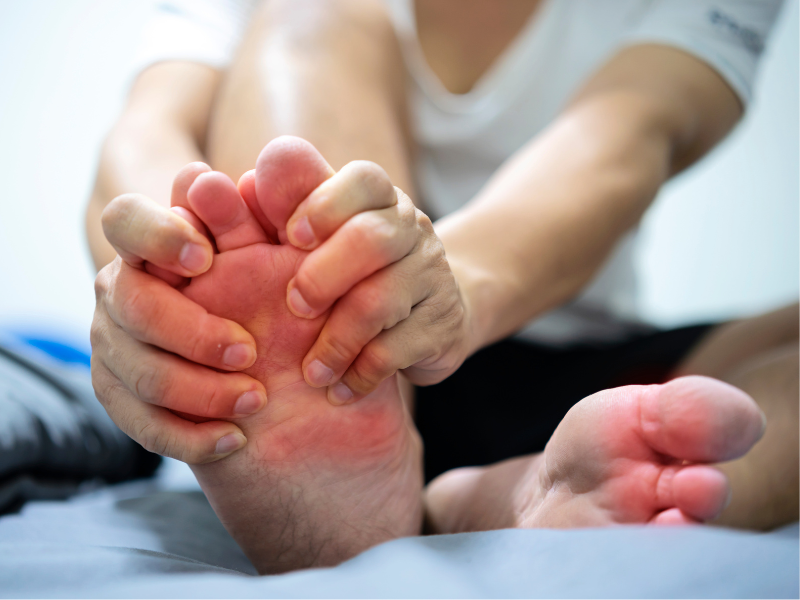
Toe pain can be caused by a variety of factors, including redness, edema, stiffness, tingling, and limited range of motion. These factors can manifest in many ways, with some appearing abruptly and others developing gradually over time.
Osteoarthritis
Osteoarthritis, also known as degenerative joint disease, is characterized by joint pain, stiffness, and inflammation caused by cartilage degeneration. Though osteoarthritis can affect every joint in the body, it most usually affects the big toe as opposed to the other four toes. This condition usually develops gradually over time, generally as a result of aging-related wear-and-tear changes. It can, however, grow more quickly after an accident.
Gout
Gout is an inflammatory type of arthritis characterized by crystal deposition in the joints caused by high uric acid levels in the body. This ailment causes joint pain, redness, and swelling, usually affecting the big toe joint. If you have gout, you should avoid seafood and alcohol since they can provoke gout attacks and make the condition worse. Dietary management can help to reduce the frequency and severity of gout attacks.
Turf Toe
Turf toe is a big toe hyperextension sprain that occurs during weight bearing as the foot pushes off the turf. Turf toe, first identified in the 1970s and called after American football players who regularly encountered it, can afflict athletes engaged in various sports and activities.
It is more common in players who play on artificial turf, which is stiffer and less forgiving than natural grass. Turf toe can develop suddenly due to a violent push-off from the turf or gradually over time as a result of recurrent stress on the big toe joint. Proper footwear and protective measures are required to prevent and manage this condition.
Fractures
Fractures, often known as shattered bones, can occur in any of the toes. Toe fractures cause severe discomfort, bruising, swelling, limited toe movement, and trouble bearing weight on the affected toes while standing or walking. To guarantee normal healing and avoid subsequent complications, toe fractures must be diagnosed and treated as soon as possible.
Sesamoiditis
Sesamoid bones are small, oval-shaped bones inserted within tendons to improve their line of pull. The flexor hallucis brevis muscle tendon in the big toe contains two sesamoid bones at the big toe joint.
Because the big toe is subjected to a great deal of pressure during sports, such as running and leaping, repetitive movements can cause pain and inflammation in the sesamoid bones, a condition known as sesamoiditis.
Sesamoiditis is more common in people who wear ill-fitting shoes and have abnormal foot alignments, such as flat feet or a club foot. Proper footwear and foot support are critical in controlling sesamoiditis and relieving discomfort.
Bunion
A bunion is a foot abnormality that causes the big toe to point toward the other toes. Bunions are sometimes ascribed to tight shoes squeezing the toes, although heredity certainly plays a part in their formation.
Bunions are painful, and their existence causes a shift in the alignment of the big toe joint, making walking difficult. Managing bunion pain and finding appropriate footwear can help relieve pain and preserve good foot health.
Corns, Calluses, & Blisters
Corns and calluses are thickened, hardened areas of skin that can occur on the feet and toes due to repetitive rubbing, friction, or pressure. Corns are small, hard patches of skin that form over bony portions of the foot, whereas calluses are larger, toughened patches. Blisters, on the other hand, form when fluid accumulates beneath the skin’s surface as a result of continual pressure and friction.
Corns, calluses, and blisters are common foot ailments caused by wearing ill-fitting shoes, prolonged walking, or going barefoot. They can cause discomfort and suffering while standing or walking, underlining the need for adequate footwear and foot care in preventing or effectively managing these conditions.
Ingrown Toenails
Ingrown toenails arise when the toes’ edges or corners grow into the surrounding skin, causing discomfort and irritation. Toe injuries, wearing tight shoes, poor foot cleanliness, and genetics can all increase the likelihood of having an ingrown toenail.
The condition can produce redness, swelling, pain, bleeding, and infections in some situations. Proper foot care and the use of well-fitting shoes can aid in the prevention of ingrown toenails and boost overall foot health. If you suspect an ingrown toenail, seek immediate attention and care to avoid further issues and relieve discomfort.
Claw & Hammer Toes
Toe abnormalities are a frequent cause of toe pain. The proximal interphalangeal (PIP) and distal interphalangeal (DIP) joints flex downward, resulting in claw toes. On the other hand, hammer toes relate to bending only the PIP joint.
Claw and hammer toes are more common in adults in their 40s and 50s and those with bunion deformities, inflammatory arthritis, and previous foot and toe traumas. Proper foot care, appropriate footwear, and seeking medical attention as soon as possible can help control and alleviate the discomfort caused by these toe abnormalities.
Dactylitis
Dactylitis is a disorder that causes the fingers or toes to enlarge, giving them a sausage-like look. This illness is frequently associated with psoriatic arthritis, an autoimmune inflammatory form of arthritis that affects people who have psoriasis, a skin inflammation.
Dactylitis can cause redness, swelling, and pain in the toes and digits. Seeking adequate medical care and controlling psoriatic arthritis can aid in symptom relief and enhance general quality of life for those with dactylitis.
Peripheral Neuropathy
Peripheral neuropathy is caused by nerve injury in many regions of the body, including the arms, hands, fingers, legs, and feet. This illness causes numbness, tingling, burning sensations, diminished feeling, and discomfort.
Various circumstances, including trauma, Guillain-Barre syndrome, peripheral vascular disease, diabetes, infections, or as a side effect of chemotherapy treatment, can cause peripheral nervous system nerve damage. Early diagnosis and treatment can help address the underlying causes and alleviate the symptoms of peripheral neuropathy.
Diagnosis of Finger & Toe Pain
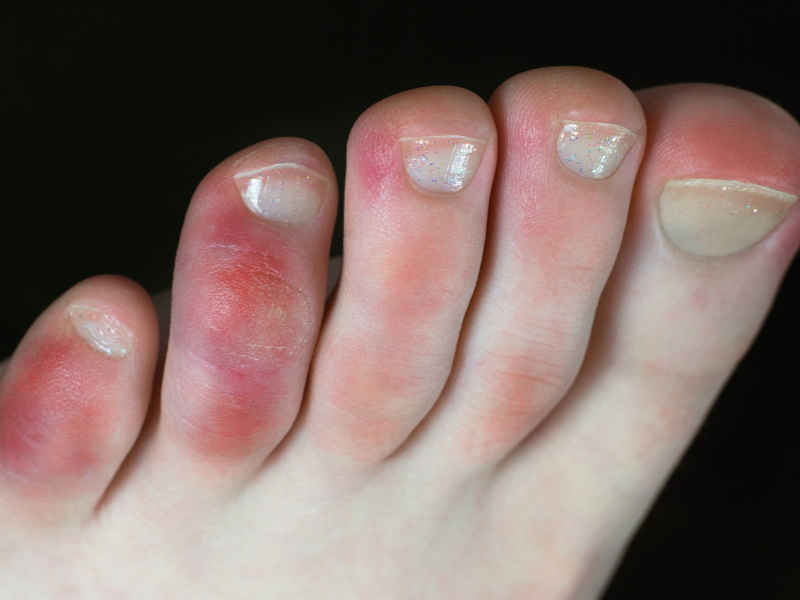
Your healthcare provider will do a complete evaluation to establish the reason for your toe discomfort, beginning with a review of your medical history, including the onset and type of your symptoms.
Medical History
Your healthcare practitioner will ask you questions regarding your illness during your visit, such as whether you have any additional symptoms, such as tingling, numbness, swelling, burning, or muscle weakness. They will also ask about the pain’s evolution and whether it happens at rest, standing, or walking.
It is critical to provide information about any previous foot or toe injuries, recent infections, fever, exhaustion, or unexplained weight loss, as these characteristics may indicate a systemic issue underlying the toe pain.
Physical Examination
A physical examination will be undertaken, emphasizing checking and touching your foot and toes. Your toe joints will be moved to determine if there are any limits or pain while moving. Redness, warmth, swelling, soreness, bruising, numbness, and atypical skin texture will be looked for by the healthcare provider.
Blood Tests
This may be recommended in some circumstances, particularly if gout, psoriatic arthritis, or infections are suspected. Blood tests can assist in detecting uric acid levels (which are commonly raised in gout patients) as well as inflammatory indicators such as C-reactive protein (CRP) and erythrocyte sedimentation rate (ESR), which are frequently elevated in autoimmune disorders.
Imaging
Imaging methods, such as X-rays or MRI, may be performed to look for symptoms of arthritis, broken bones, or tendon/ligament injuries in the tissues surrounding the affected toe joint.
Joint Aspiration
A joint aspiration may be conducted if there is a suspicion of joint infection or gout based on the symptoms. It entails taking fluid from the toe joint for testing, which aids in identifying any problems.
Treatment Options for Finger & Toe Pain
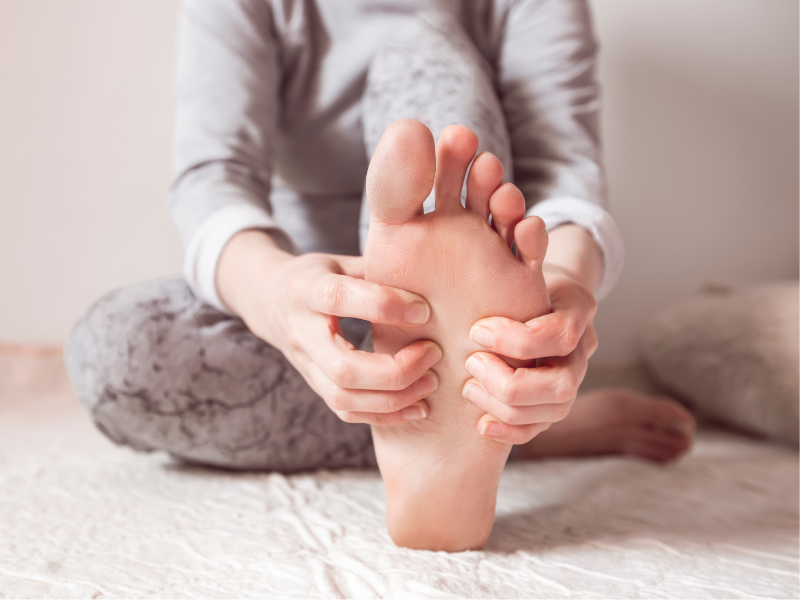
Finger & toe pain treatment options vary depending on the origin and severity of the symptoms. Conservative treatments using medicine and at-home cures can effectively control toe pain in many patients.
However, surgical intervention may be required to address the underlying issue and give relief in the case of severe or persistent injuries. It is critical to obtain competent medical guidance to find the best treatment plan for your unique problem and to ensure adequate toe care.
Lifestyle Treatment Options
To properly treat toe discomfort, you can use simple at-home techniques such as:
- Using ice or heat to relieve pain.
- Using pain-relieving lotions or gels on the skin.
- Gentle toe stretching exercises are being performed.
- Taking pauses from standing and walking for extended periods.
- Choosing supportive and well-fitting footwear.
- Bandages or cushions can be used to alleviate friction and pressure.
- Consider splinting or immobilizing your toes for support and healing.
- If you have gout, you should make dietary changes such as avoiding seafood and alcohol.
Medications
Medication can be used to relieve toe discomfort when necessary. To control pain orally, nonsteroidal anti-inflammatory medications (NSAIDs) and prescription-strength opioids are available over the counter or with a doctor’s prescription. To provide alleviation, steroid injections may be injected directly into the afflicted toe joint in some circumstances.
Individuals with systemic diseases contributing to toe discomfort may be prescribed medicine to reduce inflammation. Specific treatments, such as colchicine or allopurinol, can treat gout, whereas antibiotics treat infections, and disease-modifying anti-rheumatic drugs (DMARDs) or biologics treat autoimmune diseases such as psoriatic arthritis.
Surgery
Surgery to realign your toe joints may be considered in cases of severe toe injuries or deformities that cause continuous pain and impair your ability to stand and walk comfortably.
Other therapeutic options are usually investigated for several weeks or months before resorting to surgery. However, if you have a significant toe fracture, surgery may be performed as soon as feasible to manage the condition. Seeking competent medical counsel and thoroughly exploring your alternatives with your healthcare practitioner will help you decide on surgical intervention for your toe-related issues.
Non-Invasive Treatment
Apart from surgical methods, there are non-surgical or non-invasive treatment options for finger & toe pain. By utilizing the approach of full-spectrum healing and stem cell therapy, the experts of Regenerative Masters can alleviate your finger & toe pain.
We aim to disprove the notion that chronic pain must be tolerated indefinitely. We are convinced that cellular and regenerative therapies can relieve pain. These treatments, by utilizing the body’s natural healing mechanisms, can regenerate new tissue and reduce pain, bringing newfound hope for living a healthy life.
How Can I Prevent Finger & Toe Pain?
While accidents are unavoidable, there are practical steps you may take to reduce your risk of persistent toe pain:
- Maintain a nutritious diet as directed by your primary care physician.
- Consider any health constraints when incorporating regular exercise into your regimen.
- Remember to stretch and give your feet plenty of rest after physical exertion.
- Choose shoes that are comfy and well-fitted to your feet.
- Take regular breaks if you are on your feet for long periods of time.
- Take any foot injuries carefully until a podiatrist examines and advises you.
Conclusion
Osteoarthritis, gout, turf toe, bunions, ingrown toenails, fractures, sesamoiditis, dactylitis, claw and hammer toes, peripheral neuropathy, and corns, calluses, and blisters are all causes of finger & toe pain.
Finger & toe pain can be treated at home with over-the-counter medications and home remedies; severe or persistent causes may demand surgery to realign the toe joint and relieve discomfort. If you’re uncomfortable with the surgical methods, you can contact the experts of Regenerative Masters and utilize their non-invasive treatment methods.
Call 6128005096 to book your appointment.
FAQs
-
What are the initial signs of arthritis in the toes?
Inflammation occurs in the joint due to all forms of arthritis, leading to noticeable swelling. The toes might exhibit redness and a warm sensation when touched. This symptom often becomes apparent after prolonged sitting or upon waking up. Swelling can also create challenges when attempting to put on shoes in the morning.
-
Can arthritis in the toes be cured?
While arthritis lacks a definitive cure, numerous treatment choices exist to decelerate its advancement and alleviate symptoms. Through appropriate treatment, a significant number of individuals grappling with arthritis can effectively handle pain, sustain an active lifestyle, and experience enriching lives.
-
Is arthritis in the toes common?
Hallux rigidus, commonly known as a stiff big toe, emerges when the joint situated at the base of the big toe becomes rigid. This condition is the prevailing form of arthritis affecting the foot, often causing discomfort and hindrance in walking. Typically, hallux rigidus manifests in adults aged between 30 and 60.
